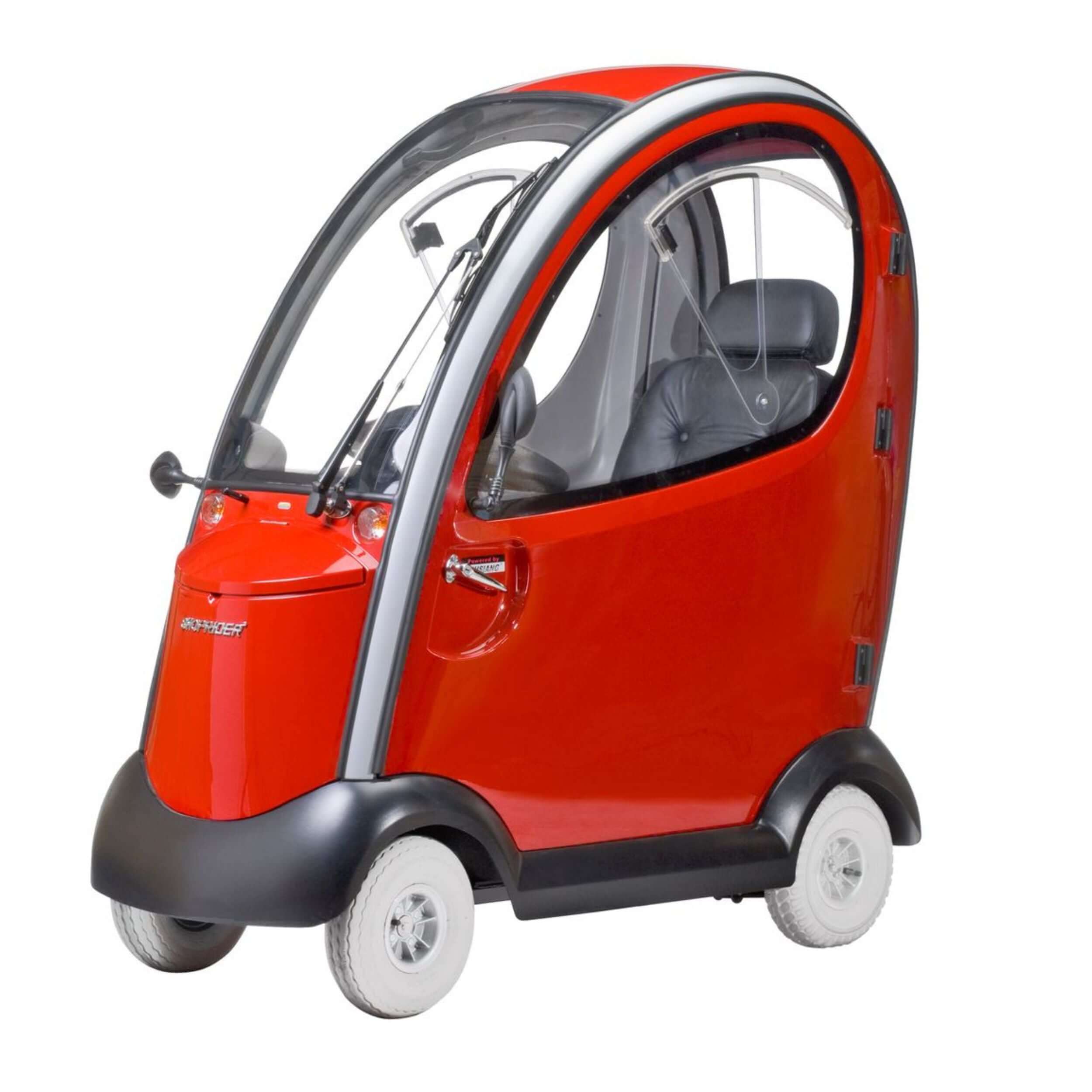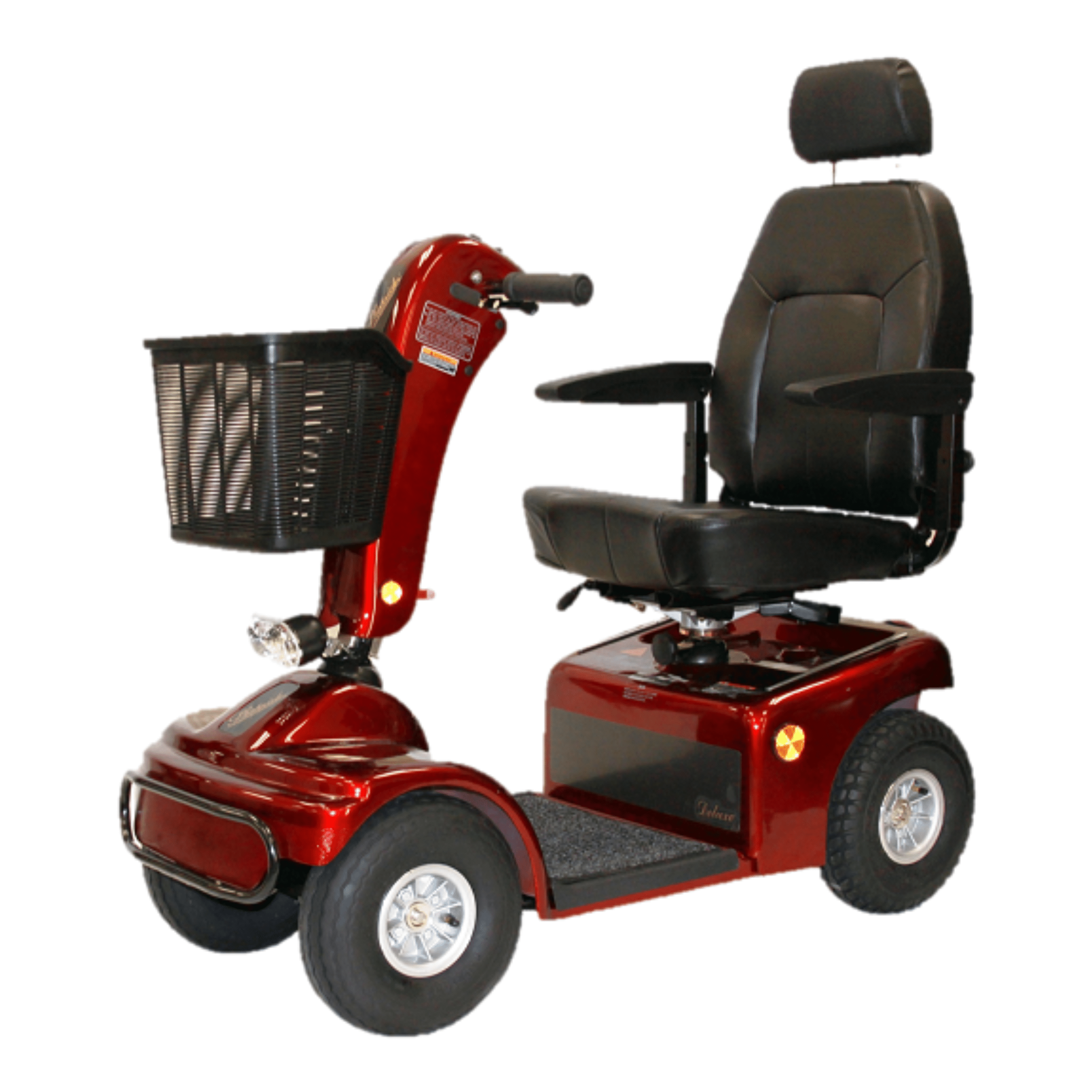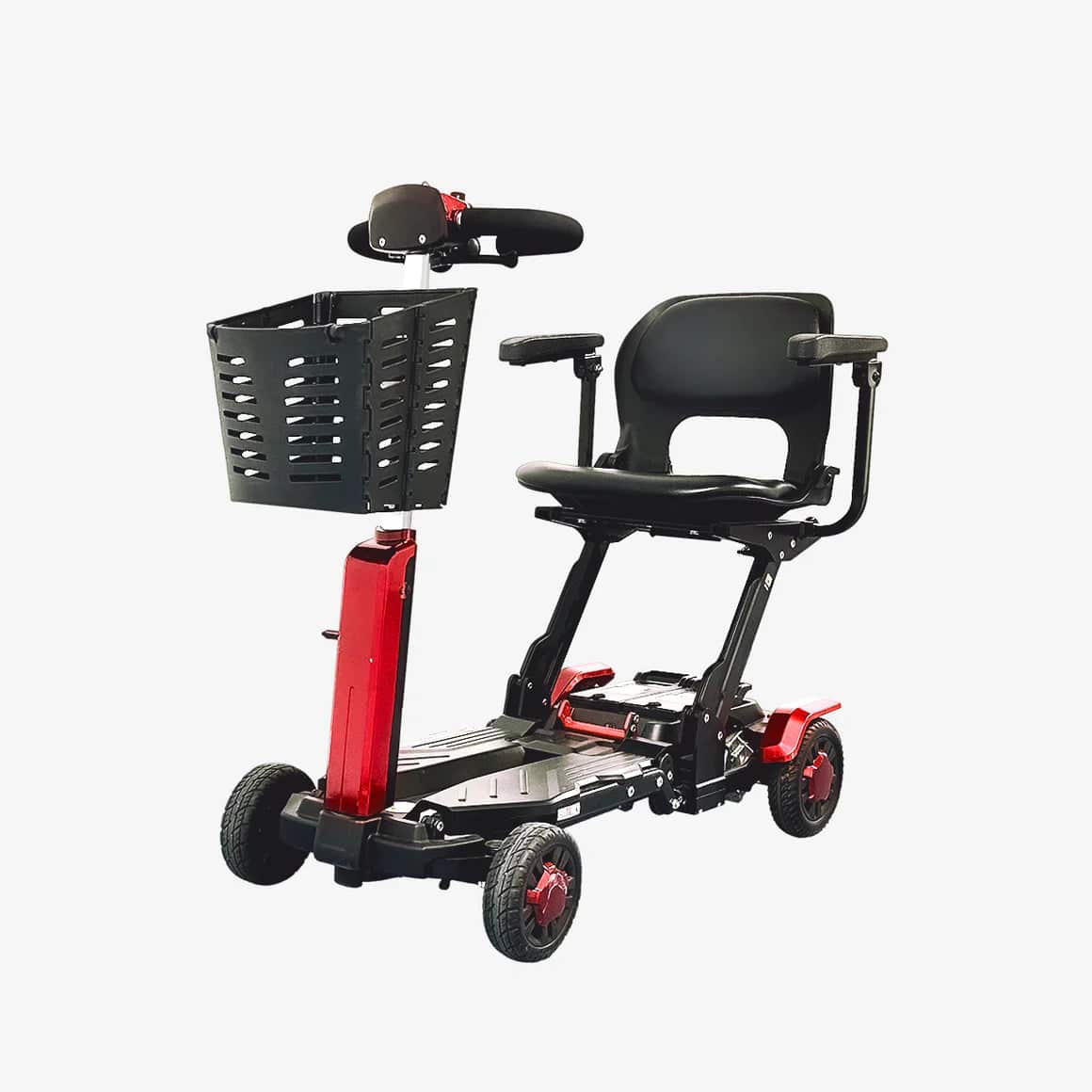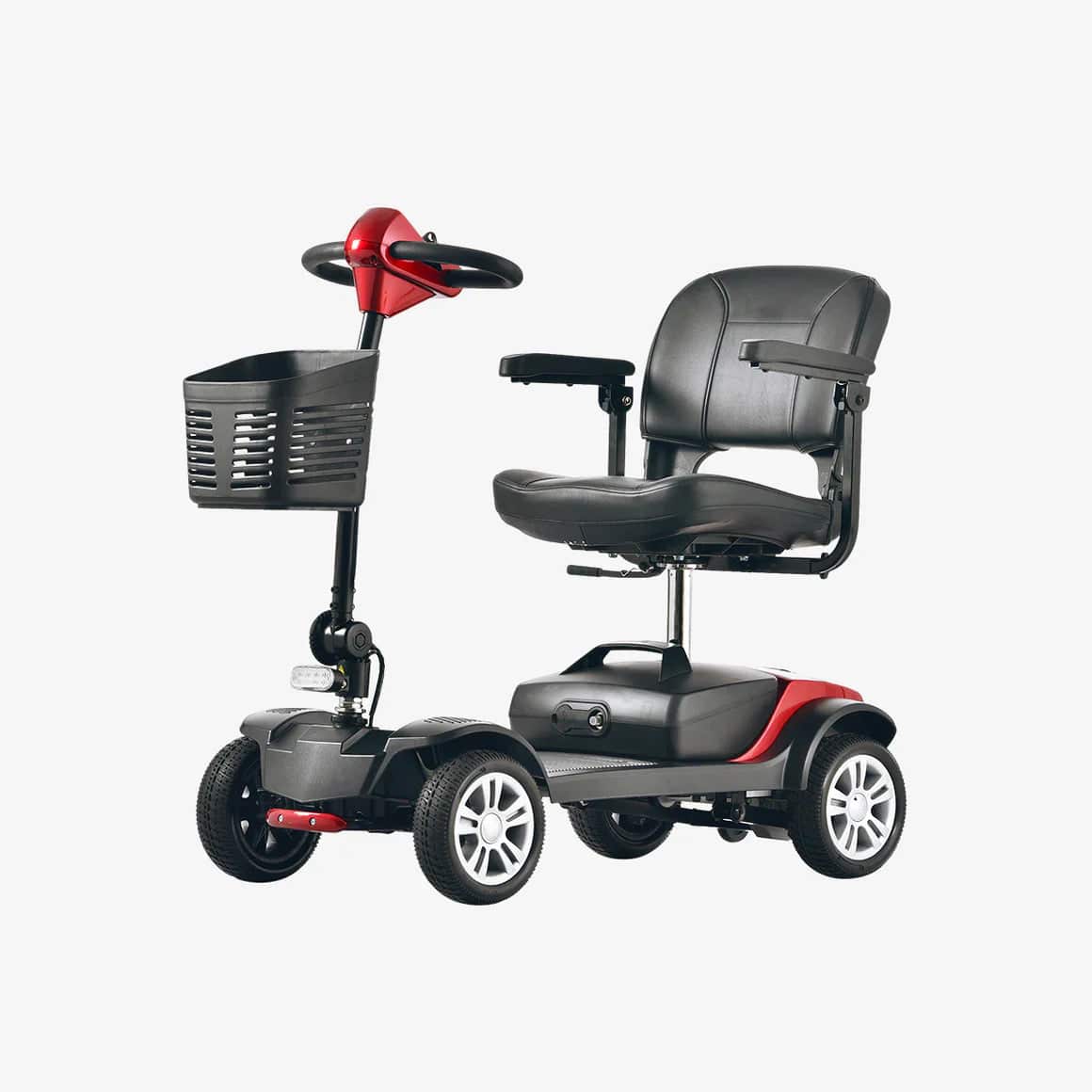Key Takeaways:
- Mobility scooters use tiller steering and excel in outdoor environments and longer distances
- Power wheelchairs offer joystick control and superior indoor maneuverability
- Scooters typically require more upper body strength and core stability than power wheelchairs
- Premium scooters like Shoprider models offer weather protection and extended range capabilities
- The right choice depends on your physical abilities, usage environment, and lifestyle needs
- Most quality mobility scooters can travel 10-20 miles on a single charge at speeds up to 5 MPH
When comparing mobility scooter vs power wheelchair options, understanding the fundamental differences helps determine which mobility aid will provide the greatest independence and functionality for your specific needs. Each solution offers distinct advantages that impact comfort, accessibility, and overall quality of life.
Understanding Mobility Scooters and Power Wheelchairs
The mobility scooter vs power wheelchair comparison begins with recognizing how these mobility aids differ in basic design, operation, and intended use. These differences significantly influence which option might better serve your particular situation.
At MedShopDirect, we offer premium Shoprider mobility scooters and Vocic mobility scooters designed to provide exceptional independence and mobility. Our collection includes diverse models for various needs, from all-weather enclosed cabins to lightweight folding designs for easy transport.
For a more detailed comparison of mobility options beyond power wheelchairs, our article on mobility scooter vs electric wheelchair differences provides additional insights.
Mobility Scooter vs Power Wheelchair: Fundamental Design Differences
The design and operational variations between these mobility aids create distinct user experiences:
Key Design and Control Differences
| Feature |
Mobility Scooters |
Power Wheelchairs |
| Control Mechanism |
Tiller steering (handlebars) |
Joystick control |
| Base Configuration |
3 or 4 wheels |
Typically 6 wheels (mid-wheel drive) |
| Seating Position |
Swivel seat with forward orientation |
Fixed seat with multiple positioning options |
| Entry/Exit |
Step-through design or swivel seat |
Side or front transfer |
| Turning Capability |
Wider turning radius (35-55") |
Tighter turning radius (20-30") |
| Drive System |
Rear-wheel or front-wheel drive |
Mid-wheel, front-wheel, or rear-wheel drive |
| Appearance |
Vehicle-like, recreational appearance |
Medical appearance with customizations |
Physical Requirements Comparison
The physical abilities required for each option vary significantly:
Mobility Scooters Require:
- Sufficient upper body strength and dexterity for steering
- Core stability to maintain upright seated position
- Ability to turn head and neck for visibility
- Some walking ability to approach and mount the scooter
- Independent transfer capability in most cases
Power Wheelchairs Accommodate:
- Limited upper body strength and dexterity
- Single-finger control via joystick
- Various seating systems for postural support
- Complete mobility limitations with no walking required
- Transfer assistance compatibility
Top Mobility Scooter Options

Shoprider Flagship Cabin Mobility Scooter
- All-weather enclosed cabin
- Maximum outdoor independence
View Product

Shoprider Sprinter XL4 Electric Mobility Scooter
- Powerful outdoor performance
- Superior comfort and stability
View Product

Vocic D91 Folding Mobility Scooter
- One-piece folding design
- 4.9 MPH maximum speed
View Product
For those specifically interested in lightweight travel options, our guide to the best lightweight mobility scooter for easy travel and daily use provides additional recommendations.
When Mobility Scooters Excel: Advantages Over Power Wheelchairs
In the mobility scooter vs power wheelchair comparison, scooters offer distinct advantages in several key scenarios:
1. Outdoor Travel and Extended Range
Mobility scooters dominate for outdoor use and distance capabilities:
-
Superior Range: Typically 10-20 miles per charge (vs. 8-15 miles for power wheelchairs)
-
Higher Speed: Usually 4-5 MPH maximum (vs. 3-4 MPH for many power wheelchairs)
-
Larger Wheels: Better handling of outdoor terrain and obstacles
-
Weather Protection: Options like the Shoprider Flagship Cabin provide full enclosure
-
Road Travel: Some models approved for road shoulder use with proper safety features
The Shoprider Sprinter XL4 exemplifies these advantages with its robust outdoor performance and comfortable ride over varied terrain.
2. Transportation and Storage Convenience
Many mobility scooters offer superior portability:
-
Disassembly Options: Many models break down into manageable components
-
Folding Technology: Models like the Vocic D91 fold as a single unit
-
Vehicle Compatibility: Fit in standard vehicles without specialized lifts
-
Lighter Weight: Generally lighter than power wheelchairs
-
Compact Storage: More efficient use of space when not in use
These portability features make scooters ideal for active users who transport their mobility aid frequently.
3. Cost Considerations
Mobility scooters often provide cost advantages:
-
Lower Initial Investment: Generally 20-40% less expensive than comparable power wheelchairs
-
Reduced Maintenance: Simpler mechanical design requires less service
-
Lower Repair Costs: Less complex electronics and fewer specialized components
-
Better Resale Value: Broader market for used scooters
-
Insurance Approval: Sometimes easier to obtain coverage for mobility scooters
For budget-conscious consumers, these financial benefits can be significant factors in the decision process.
4. Psychological and Social Benefits
The design and appearance of scooters offer distinct social advantages:
-
Recreational Appearance: Looks more like a recreational vehicle than medical equipment
-
Normalized Perception: Often perceived as a lifestyle choice rather than disability necessity
-
Pride of Ownership: Many users personalize their scooters as they would vehicles
-
Increased Confidence: Less stigma associated with scooter use in public
-
Community Connection: Many scooter user groups organize social outings
These psychological benefits can significantly impact quality of life and social engagement.
When Power Wheelchairs Excel: Advantages Over Mobility Scooters
In the mobility scooter vs power wheelchair assessment, power wheelchairs offer superior benefits in these areas:
1. Indoor Maneuverability
Power wheelchairs navigate indoor environments more effectively:
-
Tighter Turning Radius: Typically 20-30 inches (vs. 35-55 inches for scooters)
-
Mid-Wheel Drive Option: Pivots within its own footprint for tight spaces
-
Compact Footprint: Narrower width for doorways and hallways
-
Under-Table Access: Lower profile for roll-under capability at tables
-
Precision Control: Joystick offers more precise movements in confined spaces
These advantages make power wheelchairs superior for primarily indoor use and tight spaces.
2. Accommodation of Severe Disabilities
Power wheelchairs adapt to more significant physical limitations:
-
Minimal Strength Requirements: Joystick requires minimal physical capability
-
Alternative Controls: Head arrays, sip-and-puff, and eye-gaze options available
-
Positioning Systems: Tilt, recline, and elevating capabilities for those unable to shift weight
-
Medical Integration: Designed for ventilators, oxygen, and other medical devices
-
Specialized Seating: Pressure management and postural support options
For users with progressive conditions or significant disabilities, these adaptations can be essential.
3. All-Day Usability
Power wheelchairs are designed for full-time use:
-
Pressure Management: Better seating systems for all-day positioning
-
Postural Support: More adjustable for proper body alignment
-
Fatigue Reduction: Less physical exertion required for operation
-
Customized Fit: More personalized to individual body measurements
-
Weight Shift Options: Powered position changes to manage pressure and comfort
These features make power wheelchairs better suited for users who spend most of their day in their mobility device.
Additional Outstanding Mobility Scooter Options
Beyond our top three recommendations, these models offer exceptional solutions for specific mobility needs:

Shoprider Enduro XL3 Heavy Duty Mobility Scooter
The Shoprider Enduro XL3 delivers exceptional performance with a three-wheel configuration that balances maneuverability with stability. This premium heavy-duty scooter provides reliable transportation with robust features for users who demand dependable performance and comfort.
Key Features
-
Three-Wheel Design: Enhanced maneuverability with stability
-
Heavy-Duty Construction: Reliable performance and durability
-
Premium Seating: Comfortable captain's chair with adjustable features
-
Enhanced Battery Range: Extended travel capability between charges
-
Superior Suspension: Smoother ride over varied terrain
Perfect For
- Users seeking balance between maneuverability and stability
- Those who navigate both indoor and outdoor environments
- People requiring dependable daily transportation
- Situations demanding reliable performance without excessive size
View the Shoprider Enduro XL3 Scooter

Vocic D51 Explorer Lightweight Mobility Scooter
The Vocic D51 Explorer offers an excellent balance of portability and functionality, making it one of the most versatile options in the lightweight scooter category. This adaptable model excels in both indoor and outdoor environments with its thoughtful design and easy disassembly system.
Key Features
-
Excellent Maneuverability: Tight turning radius for indoor navigation
-
Easy Disassembly: Separates into lightweight components for transport
-
3.7 MPH Maximum Speed: Safe but efficient travel capability
-
Comfortable Seating: Padded seat with adjustable armrests
-
Compact Dimensions: Navigates tight spaces with ease
Perfect For
- Users who regularly navigate both indoor and outdoor environments
- Those who need to transport their scooter in a vehicle
- People seeking balance between portability and performance
- Situations requiring adaptability to various environments
View the Vocic D51 Explorer Scooter
Key Considerations for Choosing Between Mobility Scooters and Power Wheelchairs
When evaluating mobility scooter vs power wheelchair options, focus on these critical factors:
1. Physical Capabilities Assessment
Your physical abilities significantly impact which option provides more freedom:
-
Upper Body Function: Scooters require more upper body control than power wheelchairs
-
Core Strength: Scooters need trunk stability for proper positioning
-
Hand Dexterity: Power wheelchair joysticks require less grip strength than scooter tillers
-
Transfer Ability: Consider how independently you can get on and off each device
-
Endurance: Assess fatigue levels when operating each device
Honest evaluation of these factors helps determine the most appropriate mobility solution.
2. Usage Environment Analysis
Where you'll use the mobility device most frequently affects which option works better:
-
Primarily Indoor: Tight spaces favor power wheelchairs' maneuverability
-
Primarily Outdoor: Distance and terrain favor scooters like the Shoprider Sprinter XL4
-
Weather Exposure: Consider protection needs (the Shoprider Flagship Cabin offers full enclosure)
-
Mixed Use: Assess which environment represents your primary usage
-
Transportation Needs: Evaluate vehicle compatibility and lifting requirements
The best electric beds for elderly users are selected based on home environment, and similarly, mobility devices should match your usage environment.
3. Lifestyle and Daily Activities
Your typical activities influence which option better meets your needs:
-
Travel Distance: Longer distances typically favor scooters' range and comfort
-
Duration of Use: All-day users often benefit from power wheelchair positioning options
-
Social Activities: Consider venue accessibility and device appearance preferences
-
Transportation Frequency: Portable options matter for regular travelers
-
Independence Level: Assess assistance needs for device handling and operation
Matching the mobility solution to your lifestyle ensures it enhances rather than limits activities.
Customization and Accessory Options
Both mobility solutions offer customization, though in different ways:
Mobility Scooter Customizations
Popular scooter enhancements include:
-
Seating Upgrades: Enhanced cushioning and back support options
-
Storage Solutions: Baskets, pouches, and under-seat compartments
-
Weather Protection: Canopies and full enclosures like the Shoprider Flagship
-
Performance Enhancement: Extended range batteries and upgraded motors
-
Convenience Features: Cup holders, phone mounts, and cane holders
These accessories personalize the scooter experience for specific needs and preferences.
Power Wheelchair Customizations
Power wheelchair adaptations focus more on clinical needs:
-
Seating Systems: Pressure relief cushions and positioning supports
-
Control Alternatives: Various interface options beyond standard joysticks
-
Power Options: Tilt, recline, elevate, and leg elevation functions
-
Mounting Hardware: Accommodations for communication devices and ventilators
-
Medical Integration: Oxygen tank holders and medical equipment mounts
These modifications address specific medical and functional requirements.
Insurance and Funding: Understanding Coverage Differences
The mobility scooter vs power wheelchair comparison includes important coverage distinctions:
Medicare Coverage Comparison
Medicare approaches these devices differently:
Mobility Scooter Coverage (Power Operated Vehicle):
- Requires inability to use a cane, walker, or manual wheelchair
- Must have sufficient strength and postural stability to operate safely
- Need documented ability to transfer on/off and operate the tiller
- Scooter must be necessary for in-home mobility needs (not just outdoor or recreational use)
Power Wheelchair Coverage:
- Requires inability to use a mobility scooter safely
- Need documented severe limitations in upper body function
- Must have a home environment that accommodates the device
- Often requires prior authorization with specific clinical documentation
These distinctions can significantly impact out-of-pocket expenses.
Alternative Funding Resources
When insurance coverage is insufficient, consider these options:
-
Equipment Loan Programs: Community organizations offering temporary use
-
Certified Refurbished Equipment: Quality rebuilt units at reduced costs
-
Extended Payment Plans: Financing options for out-of-pocket purchases
-
Veterans Benefits: Special programs for qualifying veterans
-
Charitable Foundations: Grants for specific conditions or circumstances
These alternatives help access the optimal mobility solution despite funding constraints.
Maintenance and Longevity Comparisons
The mobility scooter vs power wheelchair assessment includes maintenance considerations:
Mobility Scooter Maintenance
Scooters typically require:
-
Battery Care: Regular charging and occasional replacement (2-3 years)
-
Tire Maintenance: Pressure checks for pneumatic tires, replacement of solid tires
-
Connection Inspection: Regular checks of disassembly points and electrical connections
-
Motor Brushes: Occasional replacement in some models
-
Lubrication: Periodic application to moving parts
Most scooter maintenance is relatively simple and can often be performed by users.
Power Wheelchair Maintenance
Power wheelchairs usually need:
-
Battery Management: Regular charging and replacement (1-2 years)
-
Controller Programming: Occasional adjustments by technicians
-
Motor Service: More complex motor systems with specialized repair needs
-
Seating Adjustments: Regular assessment of positioning components
-
Electronics Diagnostics: Specialized testing equipment for troubleshooting
Power wheelchair maintenance typically requires more professional intervention.
Transitioning Between Mobility Devices
Many users find their needs change over time:
Progressive Adaptation
Planning for changing mobility needs ensures continued independence:
-
Starting with Scooters: Often suitable for earlier stages of progressive conditions
-
Transitioning to Power Wheelchairs: May become necessary as conditions advance
-
Maintaining Both Options: Some users keep both for different situations
-
Rental Before Purchase: Tests suitability before significant investment
-
Upgrading Within Categories: Moving from portable to more robust models as needs change
Like transitioning from standard beds to electric hospital beds as needs change, mobility solutions often evolve with physical conditions.
Conclusion: Making the Right Choice
In the mobility scooter vs power wheelchair comparison, the best choice depends entirely on your specific needs, capabilities, and lifestyle patterns. Mobility scooters like the Shoprider Flagship Cabin, Shoprider Sprinter XL4, or Vocic D91 offer exceptional independence for users with sufficient upper body function who primarily travel outdoors or need transportation flexibility. Their extended range, higher speeds, and portability features make them ideal for active users who maintain some walking ability.
Power wheelchairs, conversely, provide better solutions for those with more significant physical limitations, primarily indoor use patterns, or needs for specialized seating and positioning. Their precise control, tight turning radius, and minimal strength requirements accommodate users with progressive conditions or more complex medical needs.
The most effective approach involves thorough assessment with healthcare providers, trial use of different options, and careful consideration of both current and anticipated future needs. Many users find that mobility scooters offer the perfect balance of independence, versatility, and value for their particular situation.
For personalized guidance on selecting the perfect mobility solution for your specific needs, contact our mobility specialists who can provide detailed recommendations based on your unique requirements and help you find the ideal option to enhance your freedom and independence.
Just as hospital bed mattresses enhance comfort for those with limited mobility in bed, the right mobility device extends that comfort and independence throughout your daily activities, allowing you to maintain an active, engaged lifestyle with confidence and dignity.


